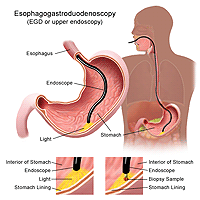Liver, Biliary, and Pancreatic Diagnostic Procedures
Liver, Biliary, and Pancreatic Diagnostic Procedures
How is a liver, biliary, or pancreatic disorder diagnosed?
In order to reach a diagnosis for liver, biliary, or pancreatic disorders, a thorough and accurate medical history will be taken by your healthcare provider, noting the symptoms you have experienced and any other pertinent information. A physical exam is also done to help assess the problem more completely.
The most commonly performed diagnostic procedures include the following:
Cholecystography (also called oral cholecystography or gallbladder series). A series of X-rays are taken of the gallbladder after a special contrast dye is swallowed, making it possible to detect gallstones, cholecystitis, and other abnormalities, although this is not commonly used.
Computed tomography scan (CT or CAT scan). This is an imaging test that uses X-rays and a computer to make detailed images of the body. A CT scan shows details of the bones, muscles, fat, and organs. CT scans are more detailed than general X-rays.
Endoscopic retrograde cholangiopancreatography (ERCP). A procedure that allows the healthcare provider to diagnose and treat problems in the liver, gallbladder, bile ducts, and pancreas. The procedure combines X-ray and the use of an endoscope, which is a long, flexible, lighted tube. The scope is guided through the patient's mouth and throat, then through the esophagus, stomach, and duodenum. The healthcare provider can examine the inside of these organs and detect any abnormalities. A tube is then passed through the scope, and a dye is injected which will allow the internal organs to appear on an X-ray.
Esophagogastroduodenoscopy (also called EGD or upper endoscopy). A procedure that allows the healthcare provider to examine the inside of the esophagus, stomach, and duodenum. A thin, flexible, lighted tube, called an endoscope, is guided into the mouth and throat, then into the esophagus, stomach, and duodenum. The endoscope allows the healthcare provider to view the inside of this area of the body, as well as to insert instruments through a scope for the removal of a sample of tissue for biopsy (if necessary).
Hepatobiliary scintigraphy. An imaging technique of the liver, bile ducts, gallbladder, and upper part of the small intestine. Also called a HIDA scan.
Laparoscopy. Use of a viewing tube with a lens or camera (and a light on the end). This is inserted through a small incision in the abdomen to examine the contents of the abdomen and remove tissue samples.
Liver biopsy. A procedure in which tissue samples from the liver are removed (with a needle or during surgery) from the body for examination under a microscope.
Magnetic resonance imaging (MRI). A diagnostic procedure that uses a combination of large magnets, radiofrequencies, and a computer to produce detailed images of organs and structures within the body.
Magnetic resonance cholangiopancreatography (MRCP). A special type of MRI that uses radio waves and magnets to obtain pictures of the bile ducts and internal organs.
Percutaneous transhepatic cholangiography (PTC). A needle is introduced through the skin and into the liver where the dye (contrast) is deposited and the bile duct structures can be viewed by X-ray.
Ultrasound (also called sonography). A diagnostic imaging technique, that uses high-frequency sound waves and a computer to create images of blood vessels, tissues, and organs. Ultrasounds are used to view internal organs of the abdomen, such as the liver, spleen, and kidneys, and to assess blood flow through various vessels.
X-ray. A diagnostic test that uses invisible electromagnetic energy beams to produce images of internal tissues, bones, and organs onto film.
Updated:
March 21, 2017
Sources:
Uncomplicated Gallstone Disease in Adults. UpToDate
Reviewed By:
Fraser, Marianne, MSN, RN,Lehrer, Jenifer, MD
